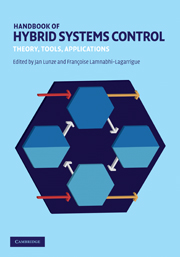Book contents
- Frontmatter
- Contents
- List of contributors
- Preface
- Notation
- Part I Theory
- 1 Introduction to hybrid systems
- 2 Survey of modeling, analysis, and control of hybrid systems
- 3 Hybrid automata
- 4 Switched and piecewise affine systems
- 5 Further switched systems
- 6 Hybrid systems: quantization and abstraction
- 7 Stochastic hybrid systems
- Part II Tools
- Part III Applications
- References
- Index
6 - Hybrid systems: quantization and abstraction
from Part I - Theory
Published online by Cambridge University Press: 21 February 2011
- Frontmatter
- Contents
- List of contributors
- Preface
- Notation
- Part I Theory
- 1 Introduction to hybrid systems
- 2 Survey of modeling, analysis, and control of hybrid systems
- 3 Hybrid automata
- 4 Switched and piecewise affine systems
- 5 Further switched systems
- 6 Hybrid systems: quantization and abstraction
- 7 Stochastic hybrid systems
- Part II Tools
- Part III Applications
- References
- Index
Summary
Several control and supervision problems for hybrid systems are posed in terms of abstract information. If the reduction of themeasurement resolution leads to quantized signals, the problem to stabilize a continuous or hybrid systems by quantized feedback has to be solved. For process supervision with abstract design specifications, it is reasonable to reduce the complexity of analysis and design tasks by using abstract models that ignore the continuous movement of the hybrid systems. This chapter shows how abstract models like automata or embedded maps can be set up and used for the diagnosis and supervisory control of hybrid systems.
Quantization and model abstraction
The subject of this chapter is a class of hybrid systems that have to be analyzed and controlled in terms of their symbolic dynamics. Only the sequence of symbolic inputs and outputs associated with the hybrid state trajectory is accessible for measurement and, hence, provides the on-line information to be used in fault diagnosis and feedback control.
The way of dealing with abstract measurement and modeling information is explained by considering quantized systems that consist of a continuous-variable system whose input, state, and output are accessible only through quantizers. The hybrid character of such systems becomes obvious from the fact that internally the system behavior is described by the continuous state x(t) whereas the outside observer only sees the quantized version [x(t)] of the state and of the input and output, which jumps between discrete (symbolic) values.
- Type
- Chapter
- Information
- Handbook of Hybrid Systems ControlTheory, Tools, Applications, pp. 193 - 248Publisher: Cambridge University PressPrint publication year: 2009

